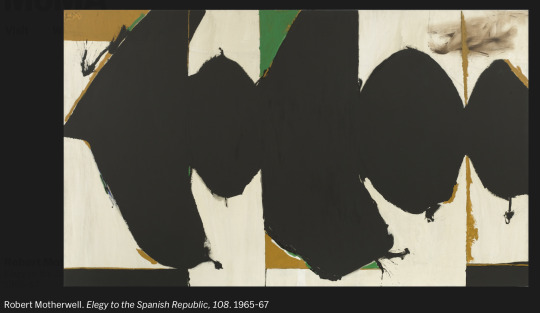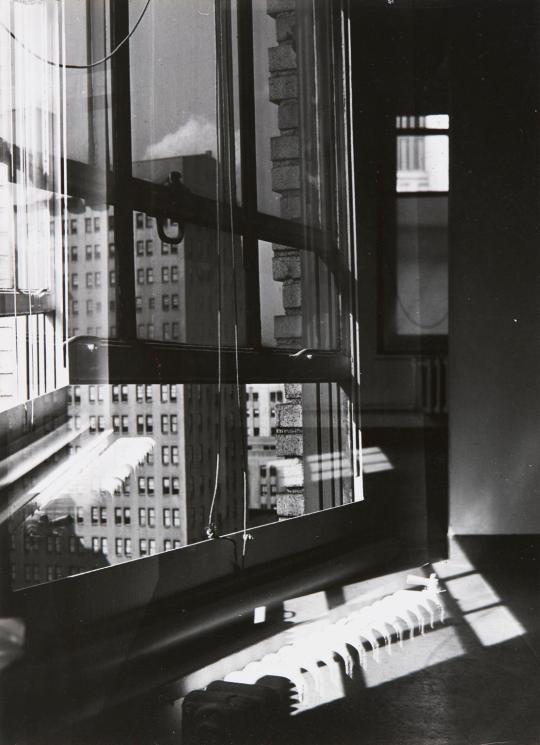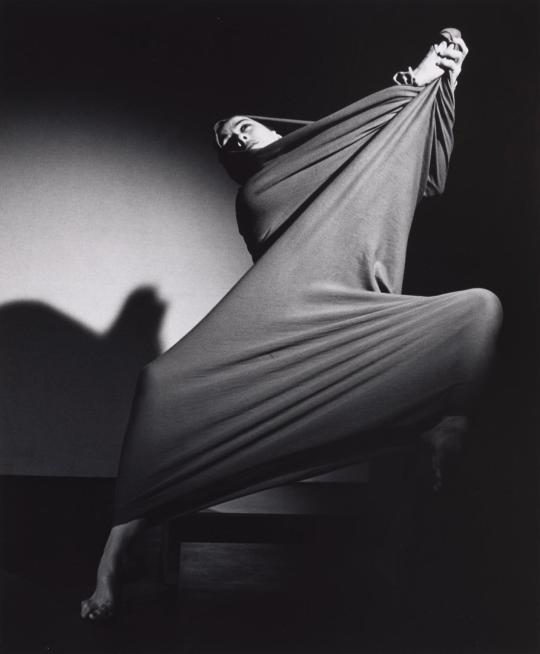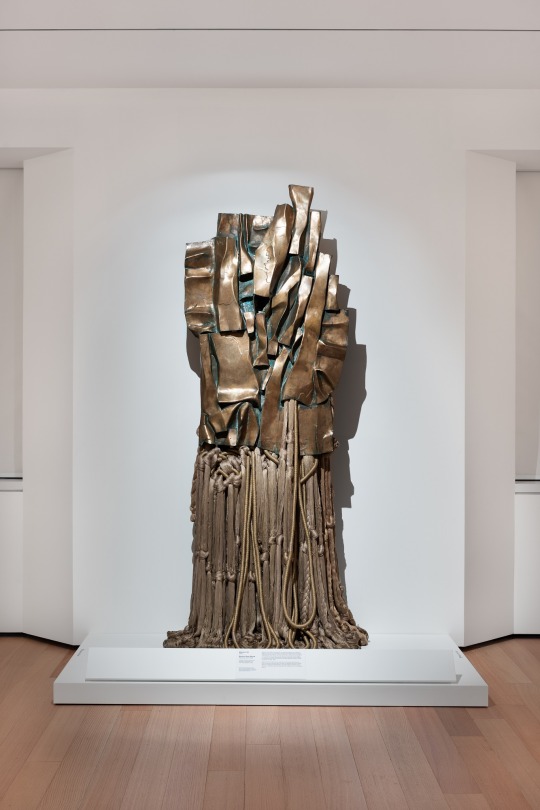#Elegy: Lament in the 20th Century
Text




Robert Motherwell -
creates paintings with elegiac motifs
https://www.moma.org/collection/works/68958
https://www.moma.org/artists/4126
https://www.moma.org/collection/works/79007
https://philamuseum.org/calendar/exhibition/elegy-lament-20th-century
0 notes
Photo

Dorothy Norman was born in Philadelphia on this day in 1905. In 1927 she met and began collaborating with photographer and gallerist Alfred Stieglitz. Norman made this photograph of Stieglitz's final gallery, An American Place, shortly after his death. Unbroken planes of light on empty walls seem to highlight his absence.
See this photograph in our installation "Elegy: Lament in the 20th Century."
"From the Window of An American Place after Stieglitz's Death," 1946, by Dorothy Norman
#Dorothy Norman#happy birthday#on this day born on this day#artist birthday#art#art museum#museum#art history#history#photography#photographer#black and white photography#Elegy: Lament in the 20th Century#Women's History Month#Alfred Stieglitz#Stieglitz#Philadelphia Museum of Art#Philly art museum#Philadelphia art museum
130 notes
·
View notes
Text
Art Opening
In another in her series of metal-on-drywall creations, we bring you this online opening of film archivist Margaret Compton’s latest work, GRAYS: Elegy Written In A College Film Archives (2020), a meditation on life, loss, and memory.

The archivist-artist’s statement about her work reads:
“Breaking away from the colorful panoply of Reel Wall (2015), I wanted to take the most ubiquitous of projection reel colors--gray--and look at it in a new way: not as the dullest of reels, but as having as much beauty as their gaudier relatives. For me, this meant arranging them in a beautiful form which would highlight their structure and let the viewer reimagine their essence. The linear form recalls weeping willows, raindrops, teardrops, symbolizing mourning, lamentation. The empty reels are memorials of the more colorful lives they once held, and this work an elegy to their past lives as carriers of our lives. It also expresses sadness at the many films never seen and those lost to neglect. Though they are all the same product with the same basic purpose, reels and films are each unique, different, worth seeing. Some say that film is dead. We know that film is not dead, that the lives on it are merely held in suspension, needing illumination to resurrect the moving images buried in our memories. Projecting and digitizing the films that were once on these reels lets us see our past again. The educational films; the kinescopes that preserve live television; the news film; the small towns views in the 1920s, '30s, '40s; the uncles, aunts, mothers, fathers, kittens, dogs, babies; the backyards, beaches, birthdays, automobiles, vacations; the Christmases, snow days, Easters, picnics, swimming pools, flowers. The past is strewn across films like autumn leaves on a churchyard's grass, but it lives. Film is memory. Memory is life. Film is not dead.”
Please consider this GRAYS’ opening and enjoy some wine and cheese while viewing it. Ponder the meaning of films in our lives while attending, virtually, #HomeMovieDay this Saturday and being celebrated by home movie enthusiasts around the world all this week. Find a Home Movie Day event online and join the cool kids in looking back over the 20th century through film! https://www.centerforhomemovies.org/hmd/
9 notes
·
View notes
Photo

Barbara Morgan described the performance "Lamentation" by Martha Graham as a “dance of sorrow . . . the personification of grief itself.” Working to portray the melancholy essence of the dance and to capture its “visual peak,” Morgan produced a dramatically diagonal image of the American modern dance pioneer. Though Graham leans on a bench, her arms and legs extend expressively to stretch the dark fabric that envelops her—a material that, according to the dancer, “indicate[s] the tragedy that obsesses the body, the ability to stretch inside your own skin, to witness and test the perimeters and boundaries of grief.”
See this photograph on view in our newest installation "Elegy: Lament in the 20th Century."
"Martha Graham - Lamentation," 1935 (negative); c. 1981 (print), by Barbara Morgan © Barbara Morgan, the Barbara Morgan Archive
#Barbara Morgan#Martha Graham#Women's History Month#photography#art#art museum#museum#art history#history#black and white photography#Elegy: Lament in the 20th Century#Lamentation#Philadelphia museum of Art#Philadelphia art museum#Philly art museum
85 notes
·
View notes
Photo

Barbara Chase-Riboud created this monumental sculpture by combining angled bronze forms with bundles of wrapped and knotted fibers. The artist was living in Paris at the time, having moved there in 1960 from her birthplace of Philadelphia. Even though she was abroad, the events of the civil rights movement in the US greatly affected Chase-Riboud and inspired her to dedicate a series of sculptures to the Black Muslim minister and activist Malcolm X. "Malcolm X #3" is a tribute to and celebration of the leader, rather than an icon of mourning. The series was not meant to represent the man in a literal sense or to lament his assassination. The artist instead created the sculptures on an aesthetic basis and dedicated them to Malcolm X as an historical person.
See this sculpture on view in our new exhibition "Elegy: Lament in the 20th Century."
"Malcolm X #3," 1969, by Barbara Chase-Riboud © Barbara Chase Riboud
#Barbara Chase-Riboud#Black History Month#Malcolm X#sculpture#contemporary sculpture#contemporary art#Elegy: Lament in the 20th Century#art#art museum#museum#art history#history#exhibitions#Philadelphia Museum of Art#Philadelphia art museum#Philly art museum
77 notes
·
View notes
Photo

Using found materials such as mop strings and broken glass, Thornton Dial, Sr., created this monumental, abstracted representation of Dr. Martin Luther King, Jr., exploring the intersection of the secular history of King’s assassination and the sacred history of Christianity. The central tiger—Dial’s primary emblem for representing Black men in his early work, because of the cat’s survival skills—symbolizes King on April 3, 1968. In the lower left-hand corner, we see with a table set with metal pots and pans, representing the Last Supper—the final meal Jesus shared with his twelve apostles the night before the Crucifixion—and signifying the impending murder of the civil rights leader.
See this work on view in our new exhibition "Elegy: Lament in the 20th Century."
"The Last Day of Martin Luther King," 1992, by Thornton Dial, Sr. © Estate of Thornton Dial / Artists Rights Society (ARS), New York
#Thornton Dial Sr.#Thornton Dial#Dr. Martin Luther King Jr.#MLK#Black History Month#Elegy: Lament in the 20th Century#art#art museum#museum#art history#history#Philadelphia Museum of Art#Philadelphia art museum#Philly art museum
49 notes
·
View notes
Photo

Doris Caesar once said, “I try to be emotional, and yet get away from reality.” Characteristic of her expressive work, this figure is elongated and gaunt. The surface of the piece is covered with marks left by the artist’s hands as she worked the clay that would later be cast in bronze. With her slumped posture, drooping shoulders, and downturned facial features, the widow’s body appears to convey the emotional weight of her grief.
See this sculpture in our newest installation "Elegy: Lament in the 20th Century."
"The Widow," around 1930–50, by Doris Caesar
#Doris Caesar#Women's History Month#Elegy: Lament in the 20th Century#elegy#sculpture#art#art museum#museum#art history#history#Philadelphia museum of Art#Philadelphia art museum#Philly art museum#The Widow#artist quote
48 notes
·
View notes